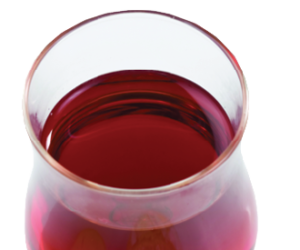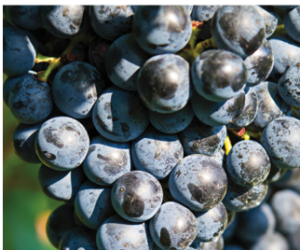Port is a fortified wine made in Portugal, but many North American winemakers are making their own versions. Use their advice to try your own Port-style wine!
Winemaker: Matt Meyer, Meyer Family Cellars, Yorkville, California
For Port wines we are big fans of Syrah and have had good results with it, but I find the most exciting variety to be Petite Sirah. Color and tannin can be an issue due to the limited time we have on skins, but Petite handles this as well as adding a bit of acid. We have tried the traditional Portuguese varieties but have found, at least with the vineyard we have worked with, that the fruit is lacking and the brandy ends up dominating the aromas.
We pick our grapes close to 23 °Brix. Most people are exposed to extremely sweet Ports, but if you travel to Portugal you will find some that are almost dry and everything in between. While ours is still sweet it is on the lower end and I find the additional acid that we capture helps balance the wine.
We are looking for about 4–6% residual sugar in our Port, so we fortify right when the fermentation is racing along. The day we stop fermentation we press it into a chilled tank, add sulfur, and fortify all at once. If the yeast dies slow, you can miss your mark, and it can create some undesirable by-products.
For yeast, you want something easy to kill that cannot stand high alcohol. There are many options these days, but being able to stop the fermentation is critical. Any flavor the yeast adds is inconsequential.
We have an ongoing blend for our Ports dating back to 1987. We only bottle every 4 years now but will add small lots of Port to the blend each year. So at this point our current Port has about 24 vintages blended.
I would recommend Tawny for home winemakers because you don’t have to worry too much about oxidation, which is often a concern with home wines. Also it’s one of the few home wines you can just leave in barrel. If you make a new vintage a couple years later you can bottle some up and top up the barrel with the new vintage.
Winemaker: Philippe Coquard, Wollersheim Winery, Prairie du Sac, Wisconsin
We produce four different kinds of Port the old fashioned Portuguese way. We use French-American hybrid grapes because we’ve been growing them for 45 years and they form our core estate wines, ranging from dry to semi-dry — we wanted our Ports to fit with this family on the sweet end. We make a Red Port using Maréchal Foch and Millot, aged 13 months in older American oak barrels. We have a Tawny Port, aged 4+ years. We also make a White Port with Muscat grapes and an un-aged Port Rosé using Foch and Edelweiss pressed at the same time. We like to pick all these grapes around 21 °Brix.
We use unaged grape brandy at 191 proof to fortify. It costs a lot more than neutral grain spirit but it tastes much better and that is what would be used in Portugal.
Using a lower proof brandy will require more and dilute the end product more. We stop the fermentation when we have about 5% alcohol (about 10 °Brix). After fortifying we aim for 19 to 20% ABV.
We use different yeasts depending on the vintage, including D21, D254, RC-212, or VL1. On a less ripe year we’ll choose a yeast that expresses softer, deeper fruit.
For home winemakers, try to keep a very cool to cold fermentation because it goes really fast . . . you need to monitor the drop of sugar and the rise of natural alcohol every 30 minutes to catch that right point. When your hydrometer reads 10 °Brix it is time to kill your fermentation by the addition of the brandy. Let it settle for a week then rack it off and the aging can start.
Winemaker: Peter Prager, Prager Winery & Port Works, St. Helena, California
We produce different styles of Port using different varietals. The main grape is Petite Sirah. Where most red grapes need a longer maceration time to pick up its rich red color and body, Petite Sirah is one of the few grapes that you can have intense color and body in just a few days. This allows us to have a finished wine with bold flavors and aging potential even with the short maceration time from Ports. We also use Tinta Roriz, which when blended, adds an elegant softness and fruitiness to the Petite Sirah. We also use Cabernet Sauvignon for our 10-year-old Tawny Port. We like this grape because we can get rich flavors but not a deep color, which makes it perfect for turning brown (tawny) during its long-term barrel aging. Chardonnay is used in our White Port production. This is a very rich grape that adds depth and flavor with long-term barrel aging, usually four to eight years.
When and how much spirit we fortify with depends on what the initial Brix is. The higher the sugars before fermentation the longer you need to ferment before you add your grape spirit to hit your residual sugar target and vice a versa. If sugars are lower, you have to fortify earlier to achieve the desired sweetness. This is why you don’t harvest just by Brix alone; pH is also very important. It’s all about balance in the finished product.
There are two types of Ports: Vintage-style and wood Ports, which we make both of. The vintage-style is out of the barrel between two and three years. This is the Port that will continue to develop in the bottle over the years, and the fruit characteristics will always be a part of the Port. The wood ports are the ones that reach full maturity (heavily oxidized) in the barrel, and are always named after their color: White, Tawny, and Ruby. White port should be in the barrel at least three years, if not longer. Tawnies have to age in the wood for a minimum of six years; we start at ten.
Since Ports don’t require much attention in the barrel because of the higher alcohol, home winemakers can bottle what they want when they want, then bottle the rest at some later date. Have fun with it.







